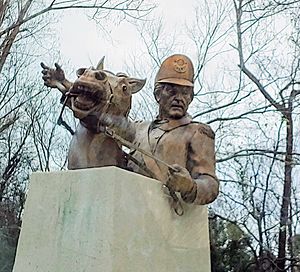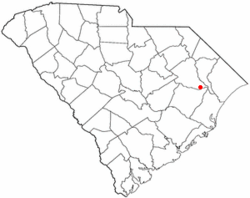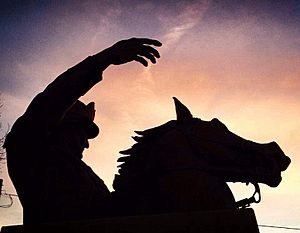Johnsonville, South Carolina facts for kids
Quick facts for kids
Johnsonville, South Carolina
|
|
|---|---|

Francis Marion statue at Venters Landing Johnsonville, South Carolina
|
|
| Motto(s):
"Outpost to the Coast"
|
|

Location of Johnsonville in South Carolina
|
|
| Country | United States |
| State | South Carolina |
| County | Florence |
| Area | |
| • Total | 2.14 sq mi (5.55 km2) |
| • Land | 2.11 sq mi (5.48 km2) |
| • Water | 0.03 sq mi (0.07 km2) |
| Elevation | 92 ft (28 m) |
| Population
(2020)
|
|
| • Total | 1,378 |
| • Density | 651.84/sq mi (251.68/km2) |
| Time zone | UTC-5 (EST) |
| • Summer (DST) | UTC-4 (EDT) |
| ZIP code |
29555
|
| Area code(s) | 843, 854 |
| FIPS code | 45-37105 |
| GNIS feature ID | 1223621 |
Johnsonville is a city in Florence County, South Carolina. In 2020, about 1,378 people lived there. It is part of the larger Florence area.
The city was started in 1913. It is located west of where Witherspoon's Ferry used to be on the Lynches River. This spot is famous because General Francis Marion received his orders for the Revolutionary War there.
Contents
History of Johnsonville
Witherspoon's Ferry and Francis Marion
Witherspoon's Ferry was an important place during the American Revolution. In 1780, General Francis Marion, also known as the "Swamp Fox," took command of the Williamsburg Militia at this ferry.
The land around the ferry changed hands over the years. In 1787, Robert Witherspoon passed the ferry lands to John Witherspoon. Later, in 1802, John gave the land to the Aimwell Presbyterian Church.
Witherspoon's Ferry was a key crossing point in the northeastern part of Williamsburg County. John Witherspoon managed the ferry until he died in 1815. His will stated that the ferry should be managed for 14 years to benefit the Aimwell Presbyterian Church.
The Johnson Family and the Post Office
In 1819, former South Carolina Governor David R. Williams, who was John Witherspoon's son-in-law, got these ferry lands. Then, in 1825, William J. Johnson bought the plantation from the Witherspoon family. He took over the ferry.
Johnson's Ferry became a busy stop for stagecoaches. Travelers would change horses and eat a meal there. When a stagecoach crossed the Lynches River on the ferry, a slave working for Mr. Johnson would blow a fox horn. Each blast meant one passenger, letting Mrs. Johnson know how many dinner plates to set.
The stagecoach also dropped off mail for nearby communities at the Johnsons' house. Because of this, Captain Johnson asked for a post office. In 1843, a post office named Johnsonville was officially opened near the ferry.
The city of Johnsonville was officially formed and recognized in 1913.
Geography and Location
Johnsonville is in the southeastern part of Florence County. Its exact location is 33°49′4″N 79°26′54″W / 33.81778°N 79.44833°W. The center of town is about 1.5 miles (2.4 km) south of where South Carolina Highways 41 and 51 cross the Lynches River.
These highways go north about 4 miles (6.4 km) to U.S. Route 378 at Kingsburg. They also go south about 5 miles (8.0 km) to Hemingway.
South Carolina Highway 341 runs through the middle of Johnsonville. It is called Broadway Street. This highway goes west about 20 miles (32 km) to Lake City. Florence, the main city of the county, is about 35 miles (56 km) to the northwest. Myrtle Beach is about 45 miles (72 km) to the east.
The city covers a total area of about 2.1 square miles (5.4 square kilometers). A small part of this, about 0.03 square miles (0.07 square kilometers), is water.
The Johnsonville Impact Crater
Johnsonville is also near a very interesting natural feature: The Johnsonville Impact Crater. This is a large, circular area that scientists believe is an ancient impact crater. It is located where the Lynches River and the Pee Dee River meet.
Snows Island, which is in that area, is thought to be the center of the crater that pushed up after the impact. This crater is about 8 miles (13 km) wide. It is not easy to see on the surface. Scientists found it by studying magnetic changes in the ground and by looking at rock samples from well drilling. They found special rocks called "impact breccia" in these samples, which supports the idea of a past impact.
Population Information
| Historical population | |||
|---|---|---|---|
| Census | Pop. | %± | |
| 1920 | 271 | — | |
| 1930 | 325 | 19.9% | |
| 1940 | 464 | 42.8% | |
| 1950 | 616 | 32.8% | |
| 1960 | 882 | 43.2% | |
| 1970 | 1,267 | 43.7% | |
| 1980 | 1,421 | 12.2% | |
| 1990 | 1,415 | −0.4% | |
| 2000 | 1,418 | 0.2% | |
| 2010 | 1,480 | 4.4% | |
| 2020 | 1,378 | −6.9% | |
| U.S. Decennial Census | |||
In 2000, there were 1,418 people living in Johnsonville. There were 532 households and 413 families. The population density was about 897 people per square mile (346 people per square kilometer).
About 35.7% of households had children under 18. About 52.8% were married couples. The average household had 2.65 people. The average family had 3.03 people.
The median age in the city was 37 years old. About 26.4% of the population was under 18. About 12.3% were 65 or older.
Education in Johnsonville
Johnsonville's public schools are part of Florence County School District 5. This is a small school district in a rural area. It covers the city of Johnsonville and the land around it. The district is about 88 square miles (228 square kilometers) and serves a total population of about 6,440 residents.
Johnsonville also has a public library. It is a branch of the Florence County Library System.
Arts and Culture
Johnsonville hosts a special event each year called the Johnsonville Heritage Festival. This festival started in 2011. It celebrates the area's history, especially its connections to the American Revolution.
Before the 2000s, there was a "Founders Day" festival held on Broadway Street. In 2022, the Heritage Festival moved back to the downtown Broadway Street area from Odell Venters Landing.
Notable People from Johnsonville
- Rosa Belle Eaddy Woodberry Dickson (1868-1953): She was an educator and a leader. In 1925, she became the first woman elected mayor in the state of South Carolina.
- General John Henry Woodberry (1889-1974): He was a Brigadier General in the United States Army. He served as the Chief Ordnance Officer for the Southwest Pacific Area during World War II from 1944 to 1945.
- Odell Venters (1917-2005): He served in the South Carolina House of Representatives from 1961 to 1968 and again from 1971 to 1977.
- Jim Maxwell: He is a retired NFL linebacker, a professional American football player.
See also
 In Spanish: Johnsonville (Carolina del Sur) para niños
In Spanish: Johnsonville (Carolina del Sur) para niños



